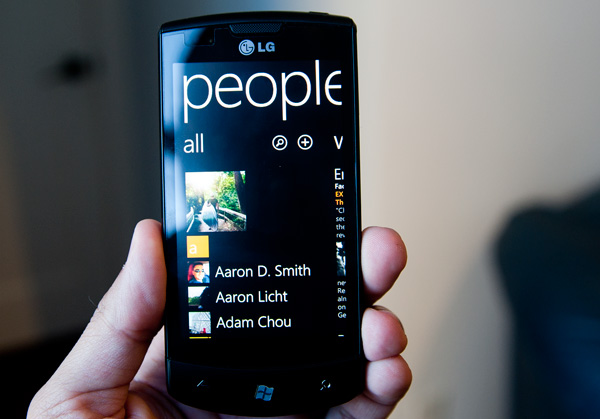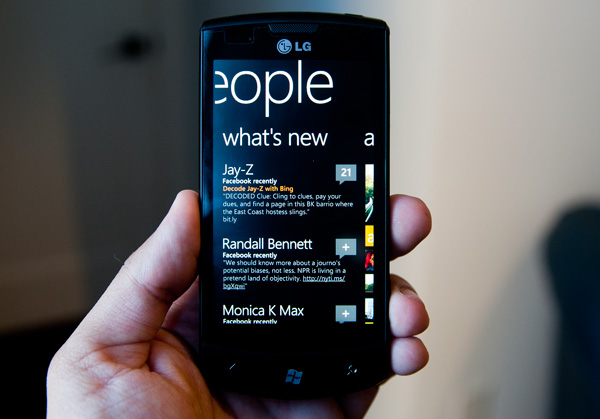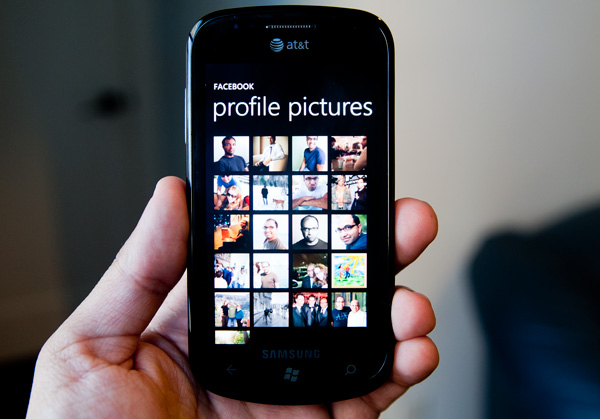The Windows Phone 7 Review
by Anand Lal Shimpi & Brian Klug on October 20, 2010 7:00 PM EST- Posted in
- Smartphones
- Windows Phone 7
- Microsoft
- Mobile
Facebook Integration
Windows Phone does the best job of Facebook integration I’ve seen of any smartphone platform.
Palm’s webOS was the first to seamlessly integrate Facebook into a modern day smartphone. Supply it with your Facebook credentials and you saw the entirety of your oversized friends list appear in your phone contacts. Email addresses, IM accounts, phone numbers and more were all automatically populated in your address book. If any of your Facebook friends changed their information, the information updated on its own on your phone. It was the wave of the future.
Spiritually, Microsoft picks up where Palm left off. You can do the same sort of blanket integration that you could with the Pre. Supply your Facebook login information and Microsoft syncs all of your contacts through the cloud. Unlike webOS however, Microsoft gives you an option to not sync all of your Facebook friends. You can choose to only sync those Facebook contacts who are already in your address book (from Google, Hotmail, Exchange or Yahoo).
Microsoft integrates Facebook in more places than just your address book however. Meet the People Hub.
People Hub
For all intents and purposes the People hub is the Facebook app for Windows Phone 7. If you’ve supplied your Facebook login, the default “what’s new” tab will serve as your news feed. It’s not the reduced load Top News feed you get from Facebook, but literally the most recent news from all of your Facebook friends and pages. You get 25 posts by default (non customizable) and there’s a get older posts button at the bottom of the page if you want to see more.
It’s not a total Facebook app replacement as you don’t get non-content updates. Items like who your friends have added to their friends list are absent from the feed. There is also no integration of friend request management. The Facebook integration is mostly for passive consumption with a couple of exceptions. You can view and add comments to posts as well as like posts, however you can’t see who has liked a post (just the number of likes for any given post).
Tapping on anyones name in the what’s new feed brings you to their contact page. You can view their “what’s new” feed and comment on their posts. You can also view their profile which will pull in data from both Facebook and your contacts (e.g. through Google or Live). Microsoft clearly (and cleanly) indicates what sources it is using to pull the profile information from under the contact’s name.
If you really like talking to/keeping tabs on/being creepy to a person, you can pin their profile to your Start screen for easy access.
From the profile tab you can write on their Facebook wall, send an email, make a phone call, send them a text message or even bring up their address on Bing maps.
All of these functions are super fast and seamlessly integrated into the experience. Quickly writing on someone’s wall without having to fire up a separate Facebook app couldn’t be faster. There’s literally a Write on wall screen that quickly appears when you select the option to. Sending an email or text message from the profile screen is a bit slower since you’re technically switching to another app, but it’s near instantaneous.
Here’s where the functionality of the back button really one-ups iOS multitasking. Let’s say I’m viewing a friend’s profile and I want to get directions to his house. I can click on his address on the profile page which will immediately fire up the Maps app. I can use Maps to quickly see where he lives (or eventually get directions) but now when I want to go back to his profile to send him a text message, there’s no double tapping or app selection - I just hit the back button and I’m back at his profile. Had I tried to get directions while at the Maps screen I would’ve tapped the back button twice (once to get out of directions and into the normal map and once again to go back to the profile) but it’s still a snappier process than manually switching between apps in iOS. The advantage is really limited to these types of scenarios however.
There’s still the need for a standalone Facebook app for more of the FB-specific features (gift giving, messaging, apps, chat, etc...), but the People hub gives you access to the most commonly used tasks. Update: A standalone Facebook app is now available for WP7.
While you can exclude Facebook friends who aren’t already in your address book from appearing in your address book, doing so will not keep those friends from appearing in your what’s new feed. The good news is that the what’s new feed will respect your Facebook news feed options. If you’ve removed someone’s updates from appearing in your Facebook news feed, their updates won’t appear in the what’s new tab on Windows Phone 7.
Today Facebook is front and center with Windows Phone, but it would be just as easy for Microsoft to extend the interface to support other social networks or status aggregators. Twitter obviously comes to mind and while Microsoft isn’t officially announcing anything yet, that’s clearly a target that we can expect to see pulled in at some point.
Aside from the news feed, there are two more tabs to the People hub: recent and all. The recent tab is actually a two-page tab that displays up to 8 tiles of people you’ve either recently communicated with or whose profiles you’ve viewed/stalked. The tiles are animated so you’ll see them alternate between a photo, photo + name, or just name.
This tab is effectively your favorites as there is no such functionality in the Phone app. You don’t get one touch dialing or emailing unfortunately, you’ll need one tap to select the contact and one more to choose your communication method.
The all tab is exactly what it sounds like - a list of all of your contacts. The topmost contact? A big link to your own profile of course, which you can use to provide status updates on your Facebook wall.
The search button will let you search through the all people tab. Results are narrowed down/highlighted as you type.
Tapping on any of the highlighted headers brings you to this screen, which you can use to jump to any other header in the list. I feel like the Android/iOS scrolling widget makes more sense but the Microsoft approach does work.
Facebook Photo Integration
What I was more impressed by was the Facebook integration in the Pictures hub. Your profile pictures and mobile uploads are both listed as albums when looking through all of your photos by date. Browsing photos you’ve synced, photos you’ve stored in the cloud and photos you’ve uploaded to Facebook is not only possible, but done sensibly. On top of all of that, there’s also a what’s new tab in the Pictures hub that just gives you a feed of all of the photos your Facebook friends have posted recently. It’s a great way to photo stalk if that’s what you ultimately end up doing on Facebook anyway.
While Palm used Facebook as a way to integrate contacts, other companies have since tried to pull status updates and photos from the service to populate your phone. Microsoft now joins the list of those who have tried, and while the integration isn’t perfect, it’s quite possibly the best attempt yet.














125 Comments
View All Comments
AssBall - Thursday, October 21, 2010 - link
LOL! Yeah, I think he needs to lay off the Ritalin.morphologia - Thursday, October 21, 2010 - link
Seems to me you are creating the problem yourself by caring about it so much. No one is forcing you to take such exception to political imagery. All you have to do is not care and the problem magically vanishes.Sheesh.
Fleeb - Saturday, October 23, 2010 - link
I did not even noticed that there is a Pepsi billboard in there up until you mentioned it. :SExelius - Wednesday, October 20, 2010 - link
Given the head start Apple and Google have, what are Microsoft's prospects with the carriers?Carrier support is obviously very important with licensed models like WP7 and Android... As Google learned with the Nexus One, what are Microsoft's prospects in mobile? Verizon is highly invested in Android, so don't look for them to push Android phones heavily, and AT&T is still riding Apple's cash cow... I don't think the two platform's positions are a coincidence.
Furthermore, is Microsoft prepared to potentially be the #3 mobile platform long-term? And that's assuming they can get out in front of RIM. I don't know that they have a chance of catching Google or Apple (Microsoft as a consumer brand is probably irreparably damaged and Google and Apple are still very popular.)
anactoraaron - Wednesday, October 20, 2010 - link
this is the #1 reason that I have right now for buying a WP7 phone. "Microsoft needs to pay the bills"??? Are you serious!?!? So their profits on Windows and Office are only for spending 1 billion on advertising and we get to eat it on seeing ads when I am searching through my email??? I can't understand the justification on not blasting MS here on this... which of their competitors do this now? This opens a door full of feces that I would rather not touch... Imagine turning on your phone to be bombarded by 3-10 ads before you can use the phone... and it starts with consumers being ok with an ad here and there while you do things not web related on your phone... "xbox live brought to your WP7 phone by Applebees- tap here to find the nearest applebees while your game loads"NO WAY MS... good try though. I guess it's up to Nokia/Intel with their meego to get my hard earned money... I am not paying for those ads on my phone - no way no how.
Smilin - Monday, October 25, 2010 - link
Which of their competitors do this now?Apple and Google that I'm aware of. Settle down beavis.
mcnabney - Wednesday, October 20, 2010 - link
Consumers know of three key smartphone products right now - Apple, Android, and RIM. The people that do know about Microsoft's previous offerings are probably still bitter.How will Microsoft overcome this deficit? They actually don't offer anything more than a nice slick interface that runs integrated functions smoothly, but falters on Apps. They won't even benefit from the latest must-have hardware - the launch phones are essentially 6 month old equipment.
RIM has always banked on the business customer, Apple with the trendy, and Android got everyone else. Well, they all have mature products now. Android was able to gain traction due to the iPhone/AT&T exclusivity which made them the only 'consumer targeted' smartphone on the other three American carriers. That was key to Android's success. There is no longer a pent-up demand for Microsoft to attach itself to.
What wasn't mentioned in the article is the competitive landscape for these devices. They will be going against superior Android hardware and a new version of the Pre. I just don't see much demand for these outside of the Zune-faithful.
lwatcdr - Thursday, October 21, 2010 - link
Yep it all comes down to on thing.Is Windows Phone 7 better in every way than IOS and Android. Frankly WebOS is also a very good mobile platform but is not getting anywhere near the buzz that it should.
Just being as good as just isn't enough when your competitors have a huge lead.
For me the big thing that WP7 offers will be ZunePass. If you are a music person that could be a huge benefit and it is a really good service I hear. I just don't think these devices are good enough and the lack of apps is a huge barrier.
AssBall - Thursday, October 21, 2010 - link
Remember the microsoft compatibility though. This OS has the potential to make for excellent corporate phones.teohhanhui - Monday, October 25, 2010 - link
Latest must-have hardware? That won't really matter to the average consumer. (And higher raw performance doesn't necessarily translate into better responsiveness, which greatly affects the user's perception of performance.)